Indexed In
- Open J Gate
- Genamics JournalSeek
- JournalTOCs
- Ulrich's Periodicals Directory
- RefSeek
- Hamdard University
- EBSCO A-Z
- OCLC- WorldCat
- Proquest Summons
- Publons
- Geneva Foundation for Medical Education and Research
- Euro Pub
- Google Scholar
Useful Links
Share This Page
Journal Flyer

Open Access Journals
- Agri and Aquaculture
- Biochemistry
- Bioinformatics & Systems Biology
- Business & Management
- Chemistry
- Clinical Sciences
- Engineering
- Food & Nutrition
- General Science
- Genetics & Molecular Biology
- Immunology & Microbiology
- Medical Sciences
- Neuroscience & Psychology
- Nursing & Health Care
- Pharmaceutical Sciences
Research Article - (2023) Volume 0, Issue 0
Trend of New Blood Donors According to Types and Socio-Demo-Bio Clinical Profiles before and during the COVID-19 Pandemic
Walo Diessa Fanny1, Longo-Mbenza Benjamin2,3, Mawalala Malengele Heritier2,4*, Kisoka Christian3, Nganga Nkanga Mireille1,3, Mpudi Masamba Lethy1, Bikaula Ngwidiwo Jacques1,4, Beia Mbombo Aurore5, Wangy Ngoy Yvon1, Bakemo Mbombile Eddy1, Mpiana Mutombo Baby1, Mukiapini Luzolo Guelord1, Salaboni Munzengi Vandersal1, Kuyangisa Boloko Alain1, Ndelembo Guy Mardell1, Matondo Grace Patricia1, Kabamba Numbi Daddy1, Diwavanga Nanitelamio Bruce1 and Fiyungu Bwende Jean-Jacques12Department of Medical DRC Biology, Walter Sisulu University, Mthatha, South Africa
3Department of Medical DRC Biology, Lomo University Research, Kinshasa, Democratic Republic of Congo
4Department of Internal Medicine, University Clinics of Kinshasa, Kinshasa, Democratic Republic of Congo
5Department of Medical Imaging, University Clinics of Kinshasa, Kinshasa, Democratic Republic of Congo
Received: 13-Oct-2023, Manuscript No. JBDT-23-23619; Editor assigned: 16-Oct-2023, Pre QC No. JBDT-23-23619 (PQ); Reviewed: 06-Nov-2023, QC No. JBDT-23-23619; Revised: 13-Nov-2023, Manuscript No. JBDT-23-23619 (R); Published: 20-Nov-2023, DOI: 10.4172/2155-9864.23.S4.017
Abstract
Objective: Blood donation is a public health concern for health systems around the world. Indeed, the recruitment and retention of blood donors remain major challenges for blood banks. The objective of the study was to assess the socio-demographic profile of new donors and changes in the donor pool to improve the targeting of recruitment.
Methods: This is a desk study that took place from June 2020 to December 2021 and focused on blood donors who donated blood to the Cliniques Universitaires de Kinshasa (CUK) blood bank from January 2016 to December 2021
Results: A total of 7791 donors were included in the study. The male sex was predominant with a sex ratio of five men to one woman. The O Rhesus positive blood group was the majority. New donors were in the minority (7%) compared to old donors (93%). a downward trend in the number of donors was observed according to the months and years of blood donation. the projection of the evolution of new donors by 2030 showed a decrease in blood donors.
Conclusion: A general downward trend in old and new donors before COVID-19 but more drastic during the COVID 19 period has been demonstrated.
Keywords
Donors; Blood donation; Reduction; Strategy; COVID-19
Introduction
In the United States and many other economically developed countries, all blood is donated by Voluntary, Unpaid Donors (VNRDs) wh ereas in the majority of resource-limited countries, the blood donor population is represented by donor’s family [1]. And, although not recommended by World Health Organization (WHO), paid donors still represent 5% of the blood donor population [2,3].
In the Democratic Republic of Congo (DRC), the proportion of voluntary donors (34%) is lower than that of family donors which represents 61% [3,4].
In other sub-Saharan African countries, the concern is even greater. This is why the WHO, in its recommendations, suggests that blood needs be estimated at between 1% to 2% of the population. These recommendations are not yet applied by everyone and as a result, the problem of imbalance between supply and demand persists glaringly [5].
The recruitment and retention of blood donors therefore remain major challenges for blood banks, which to do this, must put in place strategies to circumvent the difficulties inherent in the growing demand for blood products. Like altruism, some of these strategies, notably monetary motivation, contrasted with international standards [6,7].
In this context of searching for solutions, the COVID-19 pandemic, by disrupting almost all levels of healthcare delivery, constituted another problem to be overcome by SBs [5].
In Kinshasa, the confinement decreed by the government with the closure of universities and churches, the main campaign sites of the CUK BS, had the same negative impact on blood donation collections. In addition, the demographic evolution that the city province of Kinshasa is undergoing following the various war situations raging in the east of the DRC, and which have led to rapid urban growth, environmental and social changes (overpopulation after migration rural-urban and poor and informal settlements), could undoubtedly have serious consequences on health in general and on blood requirements in particular [8].
Thus, the objective of the present study was to evaluate the sociodemographic profile of new donors and changes in the donor pool to improve the targeting of recruitment based mainly on altruism because blood donation is considered an altruistic act and altruism is the most common self-reported motive for donating blood [9].
Materials and Methods
Design
This is a documentary study which took place from June 2020 to December 2021 and which focused on blood donors who donated blood to the blood bank of the Clinics in University of Kinshasa (CUK) from January 2016 to December 2021.
Data gathering
A pre-established and pre-coded form was used to collect sociodemographic data (age, sex, province, date of birth and address), clinical data (concept of high blood pressure, alcoholism) and biological data (blood grouping, hemoglobin level, hematocrit measurement and Human Immunodeficiency Virus (HIV), Hepatitis B and Hepatitis C Virus (HBV, HCV) and Syphilis serologies).
Statistical analyzes
The data were encoded using Excel 2010 software. After cleaning and checking consistency and quality, they were exported to SPSS 21.0 for analyses.
Descriptive statistics consisted of calculating the mean and standard deviation for continuous and normally distributed data, the median for non-Gaussian data, and the proportions (%) for categorical data.
The chi-square test allowed us to compare the proportions that of Student's t and Man Withney's U allowed us to compare the means and medians. The probability P<0.05 was the threshold for statistical significance.
Results
Sociodemographic characteristics
Sex and age: A total of 7791 blood donors were registered during the study period, including 6511 men (83.6%) and 1280 women (16.4%), i.e. a male-female sex ratio of 5. The average age of donors was 24.15 ± 6 years with a minimum of 17 and a maximum of 70 years. The median and mode were 22 years and 19 years, respectively (Figures 1 and 2) (Table 1).
| Features | Values |
|---|---|
| Central tendency | |
| Average | 24.15 |
| Median | 22.00 |
| Fashion | 19 |
| Dispersion | |
| AND | 6,146 |
| Minimum | 17 |
| Maximum | 70 |
| Posterior distribution | |
| Skewness | 0.816 |
| Kurtosis | 1,198 |
Table 1: Age characteristics (years) of the study population.
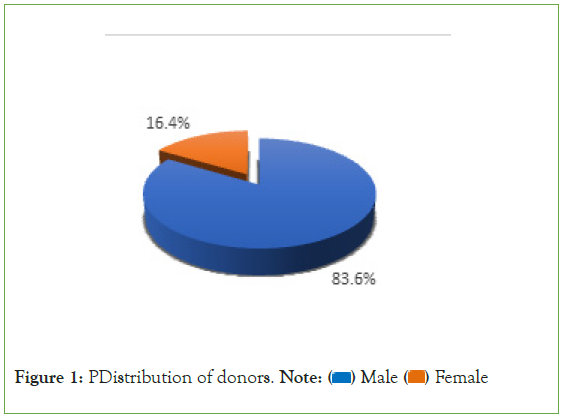
Figure 1: PDistribution of donors. Note:  Female
Female
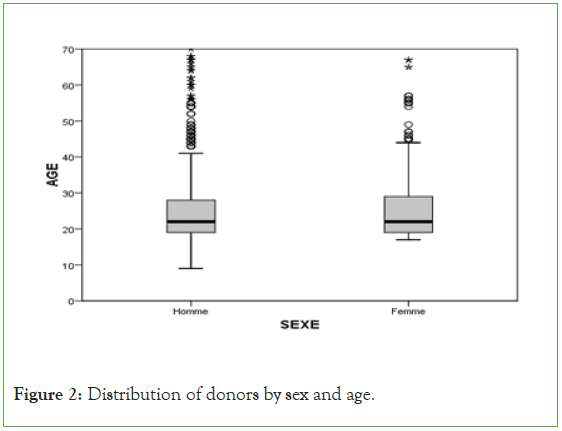
Figure 2: Distribution of donors by sex and age.
Marital status: According to the marital status of donors, singles were more numerous (n=7481; 96), followed by married (n=277) and divorced (n=33) (Figure 3).
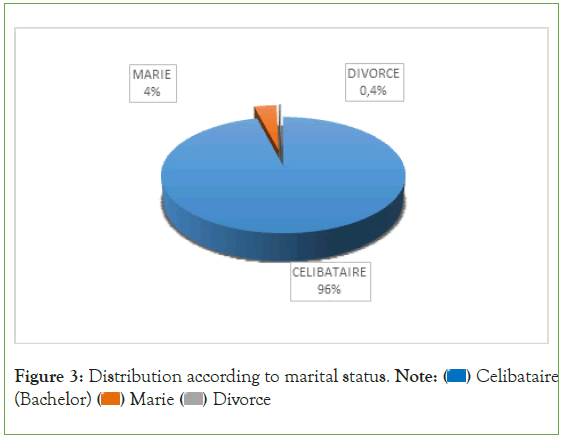
Figure 3: Distribution according to marital status. Note:  Celibataire (Bachelor)
Celibataire (Bachelor)  Divorce
Divorce
Occupation: Nearly 3/4 of the blood donors were students (n=7449) followed by liberals (n=229), civil servants (n=79), housewives (n=16), unemployed people (n=15), and security officers (n=3) (Figure 4).
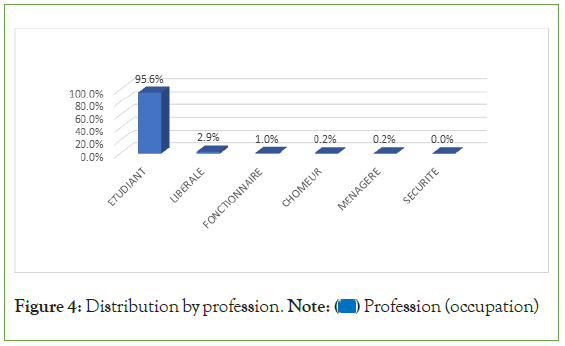
Figure 4: Distribution by profession. Note:  Profession (occupation)
Profession (occupation)
Environment and municipalities: It appears from Figure 5, that the majority of donors (n=3757 (i.e. 8.2%) came from the commune of Lemba followed by that of Limete (3183 i.e. 40.9%), Ngaba (n=329 i.e. 4. 2%) and Matete (256 or 3.3%).
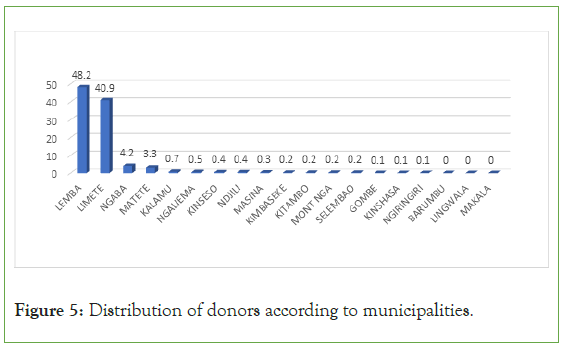
Figure 5: Distribution of donors according to municipalities.
Districts: By grouping the administrative communes into 4 Districts, nearly 8/10 of the donors lived in the Mont-Amba District (n=7558), while the scarcity of blood donors came respectively from the Districts of Lukunga (n=85), Funa (n=79), and Tshangu (n=69) (Figure 6).
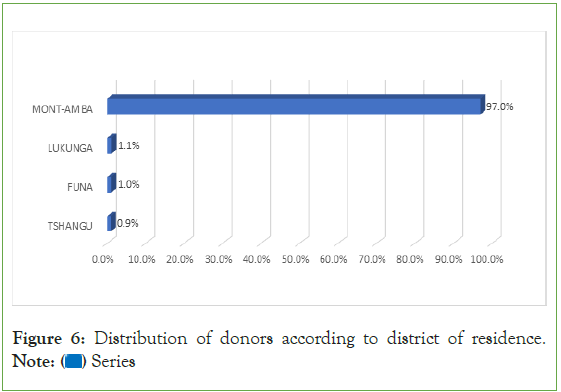
Figure 6: Distribution of donors according to district of residence. Note:  Series
Series
Genetic and non-modifiable characteristics
Ethnicity: The ethnic origin was more from the province of Kongo central (n= 5510), followed by the province of Bandundu (n= 1786), Katanga (n=244), Equateur (n= 90), Western Kasai (n=90), Eastern Kasai (38), Oriental Province (n=27), North Kivu (n=5) and North South (n=1) (Figure 7).
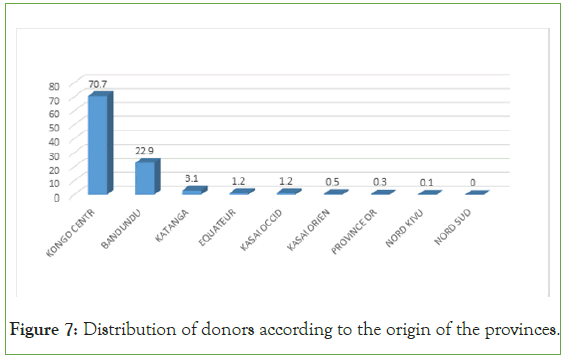
Figure 7: Distribution of donors according to the origin of the provinces.
Number of blood donors according to the ABO and Rhesus system (blood group)
ABO and rhesus system: The majority of blood donors were characterized by blood group O (n=3858), B (n=3364), A (n=495) and finally AB (n=74) (Figure 8). Likewise, the rhesus positive group was the majority among blood donors (n=7695) (Figure 9). The biological characteristics of the donors are shown in Table 2.
| Variables | Mean ± standard deviation | Extremes |
|---|---|---|
| Hematocrit | 40.8 ± 2.3 | 34-57 |
| Weight | 77 ± 7 | 50-102 |
| Temperature | 36 ± 0.6 | 35-37 |
| TN | 120 ± 3 | 100-150 |
| PAD | 79 ± 4 | 60-95 |
| Pulse | 41 ± 4 | 20-63 |
| Pulse | 79 ± 3 | 52-98 |
Note: PAD- Peripheral Arterial Disease; TN- Trigeminal Neuralgia.
Table 2: Distribution of donors according to clinical and biological parameters.
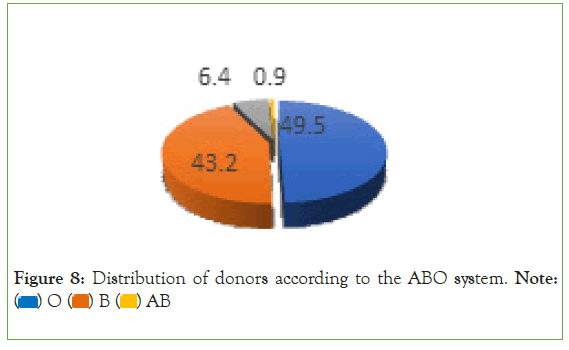
Figure 8: Distribution of donors according to the ABO system. Note:  AB
AB
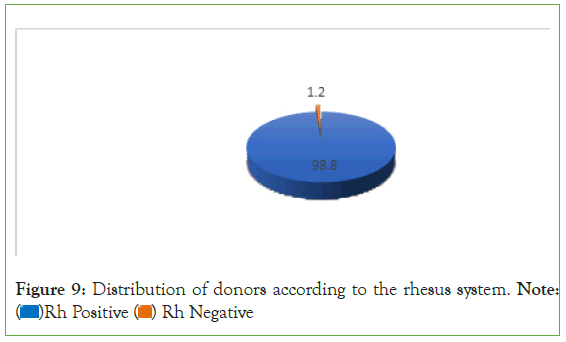
Figure 9: Distribution of donors according to the rhesus system. Note:  Rh Negative
Rh Negative
Types and nature of potential blood donors
Type of blood donors: All potential blood donors were characterized by the type of blood donation: voluntary (n=7268 or 93.3%), family (n=523 or 6.7%) (Figure 10).
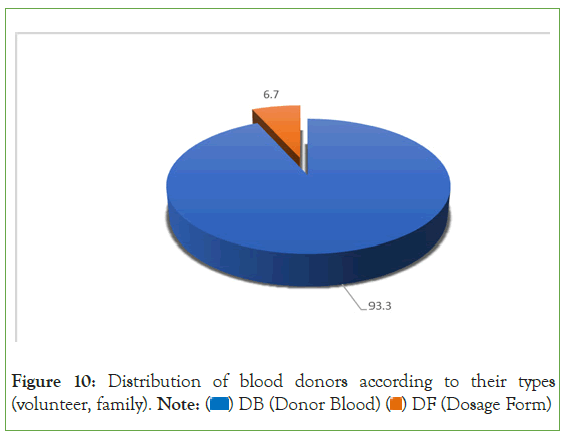
Figure 10: Distribution of blood donors according to their types (volunteer, family). Note:  DF (Dosage Form)
DF (Dosage Form)
Nature of blood donors: In addition, the nature of potential blood donors was defined as follows: old donors (n=7244 or 93.0%) and new donors (n=547 or 7.0%) (Figure 10).
Among the new donors, there was also a predominance of men, i.e. 82.1%. Considering the age of the new donors, it appears from Tables 3 and 4, that the new donors had a mean age and a median age slightly higher than the values found among the old donors.
| Former donors | New donors | |
|---|---|---|
| Average | 23.95 | 26.81 |
| Median | 22.00 | 25.00 |
| Standard deviation | 5,886 | 8,479 |
| Minimum | 9 | 17 |
| Maximum | 70 | 68 |
Table 3: Characteristics of the ages of donors according to their nature.
| DONORS | |||
|---|---|---|---|
| Serological markers | Alumni | News | Chi-2 |
| HIV | 0.000 | ||
| Positive | 22 | 9 | |
| Negative | 7222 | 534 | |
| HCV | 0.000 | ||
| Positive | 50 | 13 | |
| Negative | 7194 | 530 | |
| HBSAG | 0.000 | ||
| Positive | 32 | 20 | |
| Negative | 7212 | 523 | |
| Syphilis | 0.287 | ||
| Positive | 21 | 3 | |
| Negative | 7223 | 540 | |
Note: HIV- Human Immunodeficiency Viruses; HCV-Hepatitis C Virus; HBSAG-Hepatitis B Surface Antigen.
Table 4: Serological markers and donor types.
Serological markers and blood donors
There was a significant difference (P=0.000) between old and new donors with regard to HIV, HCV, and HVB serological markers. However, the difference was not significant for the Syphilis marker (P=0.287) (Table 4).
Furthermore, considering the nature of the donors, volunteers and family, there was no significant difference with regard to serological markers (Table 5).
| Serological markers | Donors | Chi-2 | |
|---|---|---|---|
| DB | DF | ||
| HIV | 0.954 | ||
| Positive | 29 | 2 | |
| Negative | 7239 | 521 | |
| HCV | 0.371 | ||
| Positive | 57 | 6 | |
| Negative | 7211 | 517 | |
| HBS | 0.051 | ||
| Positive | 45 | 7 | |
| Negative | 7223 | 516 | |
| Syphilis | 0.751 | ||
| Positive | 22 | 2 | |
| Negative | 7246 | 521 | |
Note: HIV- Human Immunodeficiency Virus; HCV-Hepatitis C Virus; HBS- Hepatitis B Surface; DB-Donor Blood; DF-Dosage Form.
Table 5: Serological markers and nature of blood donors.
Years of potential blood donation and exposure to the years of the COVID-19 pandemic
As illustrated in Figure 11, a drastic drop in blood donors was observed during the COVID-19 pandemic period (2020-2021) (n=1410) compared to almost ¾ of blood donors during the period from 2016 to 2019 (n=6381) not exposed to the COVID-19 pandemic (Figure 11).
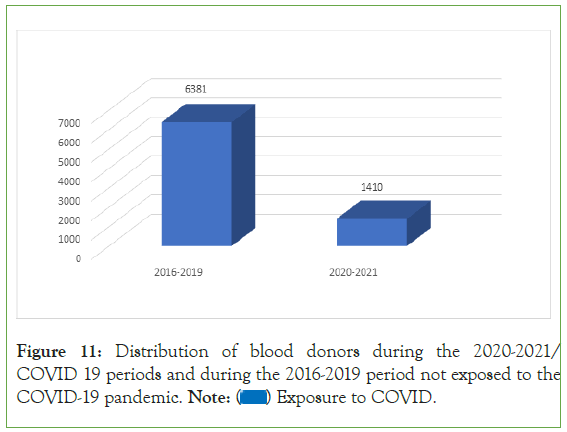
Figure 11: Distribution of blood donors during the 2020-2021/COVID 19 periods and during the 2016-2019 period not exposed to the COVID-19 pandemic. Note:  Exposure to COVID.
Exposure to COVID.
Trend of new and returning blood donors
Trend of blood donors by month: There was variability in the distribution of former donors depending on the month.
In decreasing order, the highest frequencies were observed in June (n=730), February (n=699) and January (n=660) (Figure 12).
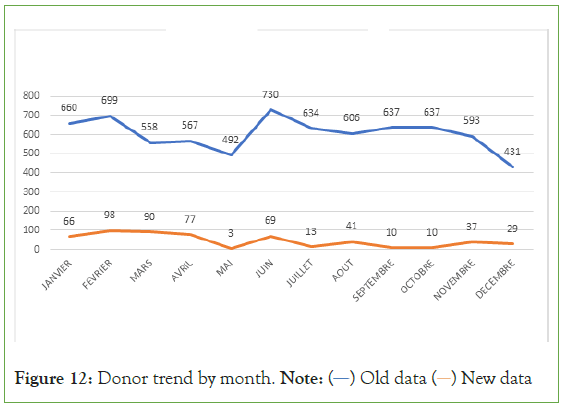
Figure 12: Donor trend by month. Note:  New data
New data
Regarding new donors, a more or less straight curve was observed from January to December.
However, the months from January to April saw the highest numbers of blood donors. The month of May was the month when the number of new donors was the lowest.
Donor trend by year: The present study showed a decrease in new donors over the years and this decrease was even more marked (drastic decrease) for new donors during the period of the COVID 19 pandemic (Figure 13).
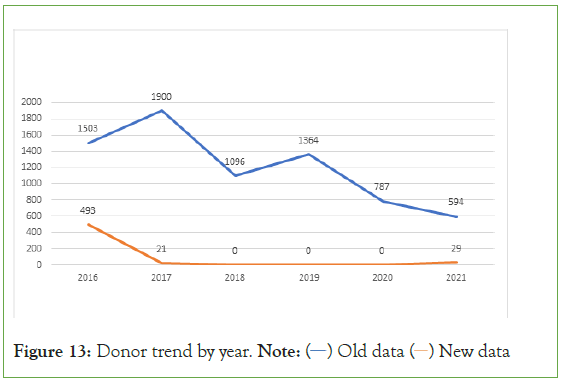
Figure 13: Donor trend by year. Note:  New data
New data
Prediction of new donor trend
The statistical analysis projecting the evolution of new donors by 2030 showed a drastic decrease (Figure 14).
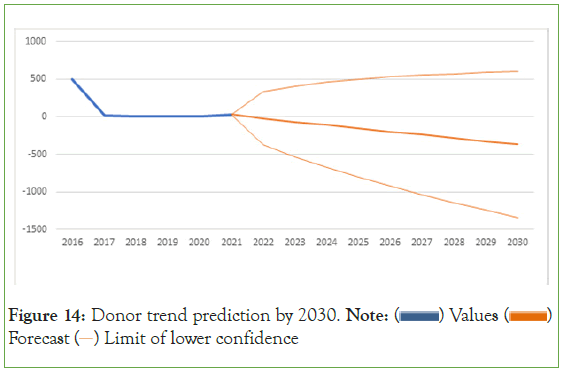
Figure 14: Donor trend prediction by 2030. Note:  Forecast
Forecast  Limit of lower confidence
Limit of lower confidence
Discussion
Socio-demographic variables
Sex: The descriptive approach highlighted the over-representation of male blood donors of around 83.6% compared to 16.4% of female blood donors in the present study. These results observed in a hospital environment in Kinshasa are similar to those of most studies carried out around the world in general and to other studies carried out in the DRC [10-13]. Indeed, a study carried out at the university clinics of Lubumbashi reported the same results (83% versus 17%), i.e. a M/F ratio of 4.93. Another study carried out in Kisangani showed a predominance of the male sex in the proportions of 71% men compared to 29% women [12].
Although it is known that men donate blood more than women following certain constraints, notably menstruation, pregnancy, breastfeeding and certain taboos, especially in Africa, certain studies have nevertheless reported neutrality or even a predominance female in blood donors [14-20]. Already in 2010 a study carried out by Baní et al reported that in many European countries, the distribution of donors considering gender is similar, with the exception of Italy where female blood donors only account for 30% [21].
Age: It appears from the present study that the majority of blood donors were young with a median age around 25 years, an age similar to that reported in other studies carried out in certain African countries (10). Indeed, according to demographic analyzes and unlike Western countries where 43% of donations are made by executives with an average age around 40-45 years; In Africa and in most countries with limited resources, blood donation is the prerogative of young people/ students around the age of 25 [12,13,22].
Marital status: In the present study, 7791 blood donors were listed with a large majority consisting of single donors (n=7481) compared to married (n=277) and divorced (n=33). These results can be explained on the one hand by the high birth rate leading to demographic growth and on the other hand by the fact that the University of Kinshasa and the students' homes constitute the essential sites of the campaigns (the majority unmarried young people) [23].
Occupation: In the present study, nearly ¾ of the blood donors were students, residents of the University of Kinshasa site, therefore more available than other professions to donate. This observation was also reported in a study carried out in the city of Kisangani which noted in descending order pupils/students (95.6%), liberals (2.9%) and civil servants (employees) (1%). Indeed, it is established that young people are generally in good health and constitute potential donors for a long period [5].
Environment and municipality: The present study reported 48.2% of blood donors residing in the commune of Lemba, a commune located near the transfusion center of the Kinshasa university clinics.
By grouping the communes into districts, blood donors living in the districts of Funa, Lukunga and Tshangu were rare and not accessible compared to blood donors coming from the district of Mont-Amba at 97%, a district which includes the commune of Lemba.
Genetic and non-modifiable characteristics
Ethnicity: Following the post-independence rebellion 1963-1965, rural-urban migrations to the agronomic and economic crises, blood donors from the Central Congo province were the majority in the present study, compared to other provinces [14,24,25].
Blood group: It is evident from the present study that the majority of blood donors in the present study were GS O Rh+ (49.5%) followed by GS B Rh+. Kabemba Bukasa in 2016 and Ghali 1 in 2019 also reported a predominance of the O Rh+ blood group among blood donors [23,26]. Indeed, in Africa the O Rhesus positive group constitutes the majority group, while in France, the most responded groups are the GS A Rh+ with 44%, followed by the GS O Rh+ with 42%. Groups B and AB represent only 10% and 4% of the population, respectively [27].
On the other hand, in India, blood group B is very widespread with 40% and generally quite widespread in South Asian countries such as Vietnam for example with 31% [28].
New donors and recruitment and retention strategies for voluntary donations
The sociodemographic characteristics of the new donors in the present study were almost similar to those of the old donors, except the mean age which was slightly higher in the new donors. Students, who constitute the majority population in sites affiliated with the CUK blood bank, are harmed by intermittent strikes by teachers and experience university courses longer than expected. This situation could justify the higher average age of new candidates for blood donation.
Against all expectations, the new donors in the present study were characterized by low prevalence’s with regard to infectious markers (HIV, HBV, HCV). But considering the nature of the donors, no statistical difference was found between voluntary donors and family donors. This fact is contrary to what is described in the literature [14,15]. Indeed, some studies have demonstrated the significant risk of transmission of Transfusion-Transmitted Infections (TTIs) by family donors [29].
Understanding the donor and their motivation (which can range from physical or social incentives to psychological altruism) is very important because it allows us to match and direct the message for awareness, recruitment and retention not only of new donors, but also former donors (regular donors) who must not be left behind [30].
Conventionally, there is no typical donor. The donor profile varies depending on historical, national and cultural contexts [31]. Indeed, income (especially in Western countries), level of education, place of residence (urban dwellers donate more than rural dwellers) are factors that can influence blood donation [32]. A few examples illustrate the impact of all these influences. In China, for example, almost 90% of donors are under 45 years old and more than half are under 25 years old, 60 to 70% of donations are made by new donors [33-36]. On the other hand, in American blood centers, up to 70% of donations come from regular donors [37].
Thus, knowledge of these profiles associated with new donors would allow 10 good targeting of the blood donation campaign site, because the judicious choice of the site can allow the implementation of broad or more circumscribed communications actions and 20 to reduce a priori a significant number of potential donors transmitting diseases transmitted by blood [37].
Years of potential blood donation and exposure to the COVID-19 pandemic years
The present study noted a drastic decrease in intention and feasibility of donating blood. This significant decrease could be explained by the advent of the COVID-19 pandemic: 18.1% of blood donors after COVID-19 (years 2020-2021) compared to 81.9% before the advent of COVID-19 (years 2016-2019). Worse still, the 2020 period with the COVID-19 pandemic presented higher proportions of eccentric districts, and marital status (married and low socio-economic level).
The COVID-19 pandemic has also impacted blood donation in other centers around the world. Thus, in countries like Saudi Arabia, donor attendance and blood supply in collection centers based on blood banks have on the one hand recorded a drop of 39.5% and on the other On the other hand, the demand for blood during the same period was reduced by 21.7% [38].
In Malaysia, despite various promotional activities, the status of blood collection had not been satisfactory reaching only 57% of the object. And during the execution of the Movement Control Order (MCO), the blood supply at the National Blood Center and other blood centers across the country had decreased by 40% compared to previous years [39].
In China, in the province of Zhejiang, not only was a drastic reduction in the number of donors up to 67% observed, but also the success rate of recruitment for donations [40].
The proportion of reduction in the number of blood donations at the regional and national level has also been reported by other countries such as Canada and the United States of America (USA) [41].
Implications of the study
The results of the present study will be important assets in the implementation of strategies targeting lower risk groups, in the recruitment and retention of new and old donors. They will also help decision-makers gain perspective on future crises and/or disasters.
A methodical approach to donor recruitment and retention must be developed and must include analysis and study of donation behavior, donor attitude, reasons for ineligibility to donate and donor abandonment the implementation of targeted loyalty programs with the analysis of responses and effectiveness, and monitoring of pools of regular (active) donors and eligible candidate donors taking into account local, national and international changes, socio-economic changes without forgetting safety requirements [42-47].
Limit and strength
This study has limitations but also strengths.
Its limitation is inherent in its documentary nature. Indeed, documentary studies suffer from the problem of completeness of files and/or registers likely to lead to possible information biases.
However, the strength of the present study lies in its large sample size. In addition, it is the first study to evaluate the tendency of new donors according to types and socio-demographic-bio clinical profiles before and during the COVID-19 pandemic.
Finally, it improves the knowledge of blood bank providers on the recruitment, awareness and retention of blood donors at the University Clinics of Kinshasa and provides blood transfusion programs with the information necessary to improve management policy donors (recruitment and retention) in the Democratic Republic of the Congo (DRC).
Conclusion
The present study, which aimed to evaluate the trend of new donors according to the types and socio-demographic-bio clinical profiles, demonstrated an overall trend towards the reduction of old donors as well as new donors before the COVID-19 period but more drastic during the COVID-19 period.
Knowledge of the donor profile will make it possible to implement strategies to recruit and retain new and old blood donors.
However, donor recruitment and retention is not an easy task to undertake. Thus, the dedication and commitment of staff ready to invest in understanding and exploring all possible strategies; resources and research will be necessary to recruit and retain and ultimately achieve blood self-sufficiency and thereby meet the increasingly growing demand for blood products.
References
- Marwaha N. Whole blood and component use in resource poor setting. Biologicals. 2010; 38(1):68-71.
- Allain JP, Sibinga CT. Family donors are critical and legitimate in developing countries. Asian J Transfus Sci. 2016;10(1):5-11.
- Kabinda Maotela J, Ramazani SY, Misingi P, Dramaix-wimet M. Blood transfusion in the Democratic Republic of Congo: Effort and challenges. Med Sante Trop. 2015;25(4):342-349.
[Crossref] [Google Scholar] [PubMed]
- Blood safety and availability. World Heal Org. 2023
- Ambroise L, Prim-Allaz I, Martine Seville attracting and retaining blood donors. Hal open. 2010.
- Recruitment, selection and retention of blood donors in Burkina Faso: inventory and proposed solutions by Issaka SONDE University of Liège, online dissertation. 2010.
- Schabas WA. Flexible financing WHO? An analysis of the voluntary contributions of its. Oxford Comm Int Law. 2016;
[Crossref] [Google Scholar] [PubMed]
- Voluntary blood donation: foundation of a safe and sufficient blood supply. World Heal Org. 2010.
- Flickenger R. Blood donation in Morocco: Underexploited potential by zineb aqboub. Anthro Human Sci. 2021; 10 (30).
- Erikstrup C, Sørensen E, Nielsen KR, Bruun MT, Petersen MS, Rostgaard K, et al.Cohort profile: Danish blood donor study, Int J Epidemiol. 2022;52(3):162-171.
- Agasa SB, Likwela JL. Barriers to voluntary blood donation in the population of Kisangani in the Democratic Republic of Congo. Pan Afr Med J. 2014;17:306.
[Crossref] [Google Scholar] [PubMed]
- kakisingi CN, Mukuku O, mMatanda SK, Manika MM, Kyabu VK, Kasamba EI, et al. Epidemiological profile and seroprevalence of blood donors at university clinics in Lubumbashi, Democratic Republic of Congo. Pan African Med J. 2016;23: 175.
[Crossref]
- Migration en Republique democratique du Congo. 2009.
- Misje AH, Bosnes V, Ga sdal O, Heier HE. Motivation, recruitment and retention of voluntary non-remunerated blood donors: A survey-based questionnaire study. Vox Sang 2005; 89:236–244.
[Crossref] [Google Scholar] [PubMed]
- Newman B. Blood donor suitability and allogenic whole blood donation. Transfus Med Rev. 2001; 15:234–244.
[Crossref] [Google Scholar] [PubMed]
- Cardigan R. Guide to the preparation, use and quality assurance of blood components, 13th edn. Coun Eur Pub. 2007;(95) 15: 871.
- Royse D, Doochin KE. Multi-gallon blood donors: Who are they? Transfusion. 1995; 35:826–831.
[Crossref] [Google Scholar] [PubMed]
- Ferda-ndez-Montoya A, Lopez-Berrio A, Luna del Castillo JD. How some attitudes, beliefs and motivations of Spanish blood donors evolve over time. Vox Sang. 1998; 74:140–147.
[Crossref] [Google Scholar] [PubMed]
- James RC, Matthews DE: Analysis of blood donor return behavior using survival regression methods. Transfus Med. 1996; 6:21–30.
[Crossref] [Google Scholar] [PubMed]
- Kebalo AH, Gizaw ST, Gnanasekaran N, Areda BG. Lipid and haematologic profiling of regular blood donors revealed health benefits. J Blood Med. 2022;13:385–394.
[Crossref] [Google Scholar] [PubMed]
- Sumbu B, Bossa EJ, Muwonga MJ, Nganga NM, Longo-Mbenza B, Ahuka-Mundeke S, et al. Seroprevalence and determinants of Hepatitis b among blood donors in the university clinics of Kinshasa (2003-2006, 2008- 2013). Inte J Heal Sci Res. 2020; 10(2):150-158.
- Ghali BE, Mohammed O, Hicham Y, Mustapha AA. The phenotypic and genotypic frequencies of the ABO and Rh systems in the Moroccan population: experience of the transfusion department of the Avicenne Military Hospital, Marrakech. Pan African Med J. 2019; 7(4):79-83.
[Crossref]
- Rebellion a Stanleyville, au Congo. Pers Monde. 1964.
- Muteba D, Nkulu J. Food crises and mitigation measures in the Democratic Republic of Congo. Rev Strat Prom Prac. 2019; 51.
[Crossref]
- Bukasa HK. Epidemiological profile of Abo and rhesus blood groups in Kalemie (DR Congo). Med African Noire. 2016; 63(5): 287-291.
- Jenik C. Quels groupes sanguins sont les plus répandus ? Dist Group Sang. 2021.
- Michas F. Distribution of blood groups in the French population, according to the Rh system. Heal Phar Med. 2021.
- Mremi A, Yahaya JJ, Nyindo M, Mollel E. Transfusion-Transmitted Infections and associated risk factors at the Northern Zone Blood Transfusion Center in Tanzania: A study of blood donors between 2017 and 2019. PLoS One. 2021;16(3): 0249061.
[Crossref] [Google Scholar] [PubMed]
- Lee CK, Hong J, Hung ATF. An update of blood donor recruitment and retention in Hong Kong. Asian J Transf Sci. 2008; 2(2): 47-50.
- Piersma TW, Bekkers R, Klinkenberg E. Individual, contextual, and network characteristics of blood donors and non-donors: A systematic review of recent literature. Blood Transfus. 2017;15:382-397.
[Crossref] [Google Scholar] [PubMed]
- Burgdorf KS, Simonsen J, Sundby A. Socio-demographic characteristics of Danish blood donors. PLoS One. 2017;12(2):0169112.
- Yang BC, Shao C, Zhang Y. Two decades of voluntary non-remunerated blood donation in Shenzhen, China. Transfusion. 2015;55:1108-1114.
[Crossref] [Google Scholar] [PubMed]
- Shi L, Wang J, Liu Z. Blood donor management in China. Transfus Med Hemother. 2014;41:273-282.
[Crossref] [Google Scholar] [PubMed]
- Wang J, Guo N, Guo X, Li J, Wen GX, Yang T, et al. Who donates blood at five ethnically and geographically diverse blood centers in China in 2008. Transfusion. 2010;50:2686-2694.
[Crossref] [Google Scholar] [PubMed]
- AABB surveys and reports. 2016.
- Strategic framework for blood safety and availability of blood products 2016-2025 WHO September 2016. 2016.
- Alo Y. Gaston of blood supply and demand during the COVID-19 pandemic, at King Abdulah Hospital, Bicha, Saudi Arabia. Trans Apheresis Sci. 2020; 59(5): 102836.
- Hamidi N, Tan YR, Jawahir S, TanEH. Determinants of community pharmacy utilisation among the adult population in Malaysia: Findings from the national health and morbidity survey 2019. BMC Health Serv Res. 2021; 21: 649.
- Wu Z, McGoogan JM. Characteristics of and important lessons from the coronavirus disease 2019 (COVID-19) outbreak in China: Summary of a report of 72,314 cases from the Chinese center for disease control and prevention. JAMA. 2020; 323(13): 1239–1242.
[Crossref] [Google Scholar] [PubMed]
- Repercussions de la COVID-19 sur le don de sang au Canada. Transfusion. 2021.
- Hong J, Loke A. Hong Kong young people's blood donation behavior. Asian J Transfus Sci. 2011;5:49-52.
[Crossref] [Google Scholar] [PubMed]
- Ou-Yang J, Bei C. Blood donation in Guangdong Province, China, from 2006-2014. Transfus Med. 2016;26:195-201.
[Crossref] [Google Scholar] [PubMed]
- Shi L, Wang J, Stevens L, Ness P, Shan H. Blood safety and availability: continuing challenges in China's blood banking system. Transfusion. 2014;54:471-482.
[Crossref] [Google Scholar] [PubMed]
- Shi L, Wang J, Liu Z, Stevens L, Sadler A, Ness P, et al. Blood donor management in China. Transfus Med Hemother. 2014;41:273-282.
[Crossref] [Google Scholar] [PubMed]
- Wang J, Guo N, Guo X, Li J, Wen GX, Yang T, et al. Who donates blood at five ethnically and geographically diverse blood centers in China in 2008. Transfusion. 2010;50:2686-2694.
[Crossref] [Google Scholar] [PubMed]
- Yang BC, Shao C, Zhang Y, Kong L, Xu YP. Two decades of voluntary non-remunerated blood donation in Shenzhen, China. Transfusion. 2015;55:1108-1114.
[Crossref] [Google Scholar] [PubMed]
- Lee CK, Hong J, Hung AT. An update of blood donor recruitment and retention in Hong Kong. Asian J Transf Sci. 2008; 2(2): 47-51.
[Crossref] [Google Scholar] [PubMed]
Citation: Fanny WD, Benjamin LM, Heritier MM, Christian K, Mireille NN, Lethy MM, et al. (2023) Trend of New Blood Donors According to Types and Socio-Demo-Bio clinical Profiles before and during the COVID-19 Pandemic. J Blood Disord Transfus. S4.017.
Copyright: © 2023 Fanny WD et al. This is an open-access article distributed under the terms of the Creative Commons Attribution License, which permits unrestricted use, distribution, and reproduction in any medium, provided the original author and source are credited.

